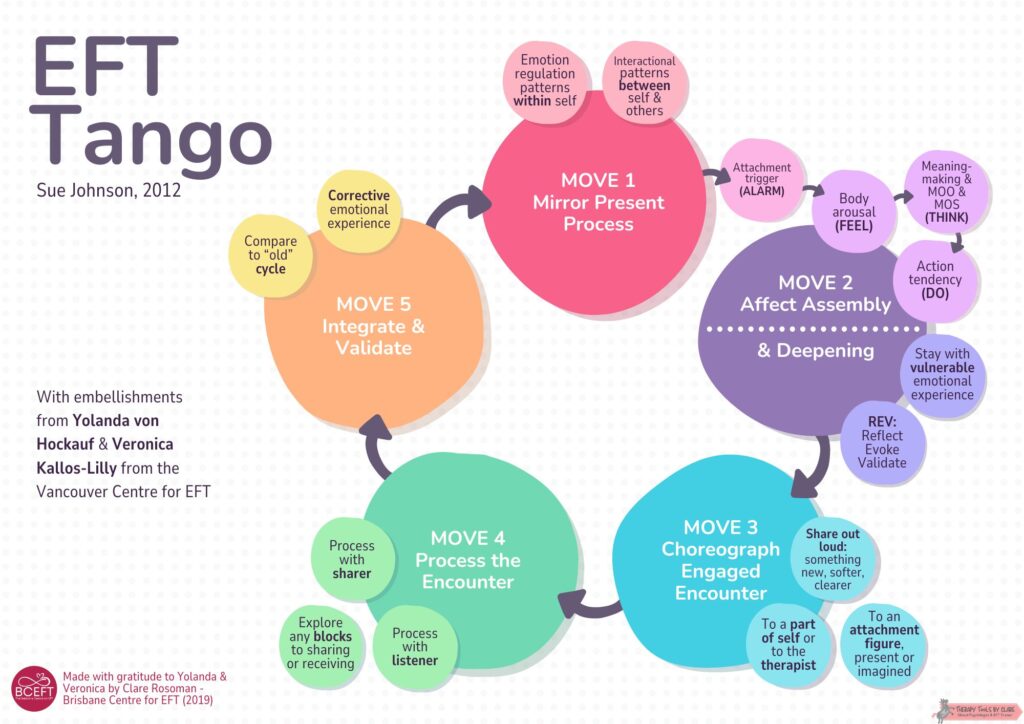What is a TANGO EFT?

Going through the EFT therapy is not simply an intellectual process. Instead it is a highly experiential process of getting in touch with feelings, communicating these feelings, and experiencing what changes inside of you when you do so.
Stages and Steps are like the music for the dance of therapy— it’s in the background, it helps us keep time, it keeps us in the mood. But even though we know the music (and love it!) we can still find ourselves stuck, anxiously tapping our toes in our chairs instead of dancing when our clients escalate into anger or touch some pain or sadness. “What do we do NOW?” Just because we know the music (the Stages and Steps) doesn’t mean we always know how to dance—when to lean in, when to have them turn, how to lead our clients gently but purposefully in the way we know they need to move and attune and reach.
To facilitate this level of experiential change the therapist does not primarily educate clients about the theoretical concepts that comprise the EFT model. Instead follows a highly developed method intended to help clients in get in touch with feelings and have an experience of change rather than just an intellectual understanding. This is where the EFT Tango comes in. It is a simple dance set, one that repeats over and over again in session. If you get lost and miss a beat, you can dance right back into it.
A simple illustration of how this experiential learning is accomplished is Sue Johnson’s EFT Tango:

The tango of EFT is a circular process by which the therapist helps each partner develop greater awareness of their feelings, communicate these, an experience the change that results from doing things in a new way:
- First the therapist notices or helps the couple notice what is happening or going in inside or between them in this particular moment (“what is happening for you right now? What just happened inside when you saw your partner do or say X?”)
- Then the awareness is expanded or deepened to the point that something fresh or new about the experience is brought to the fore (most notably a primary emotion or attachment needs or fear)
- Then the partner who has articulated something new and more vulnerable about their experience is encouraged to communicate this to their partner directly (encounter)
- Then the new communication becomes the target of exploration (“what was it like to say this? hear this?”)
- Then the new positive outcome is celebrated and the couple is helped to realize cognitively that they have done something new and how this has led to a different result (“do you notice how by being more vulnerable you got a different response? How great that you are able to do this!”)
Clare Rosoman, certified EFT trainer from Australia, worked on this detailed EFT Tango “plus” with her mentors Veronica Kallos-Lilly and Yolanda von Hockauf when she was with them in Vancouver during her EFT Trainer-in-training program in 2019. She loved their embellishments and Barbara Sławik, certified EFT supervisor, loved them too. Clare one more time allow Barbara to make a translation into local langage for Polish community. We hope you love it and find it helpful as well 😍
If you’d like an A4 copy you can download it HERE.
March 20th 2024
text: Barbara Sławik picture: merlin lightpainting
ways to help
for therapists
mentalia
mentalia.pl is owned by
„Mental Breathes” Barbara Sławik
ul. Wałbrzyska 48/11
02-739 Warszawa
Privacy Policy
Information clause on processing of personal data


